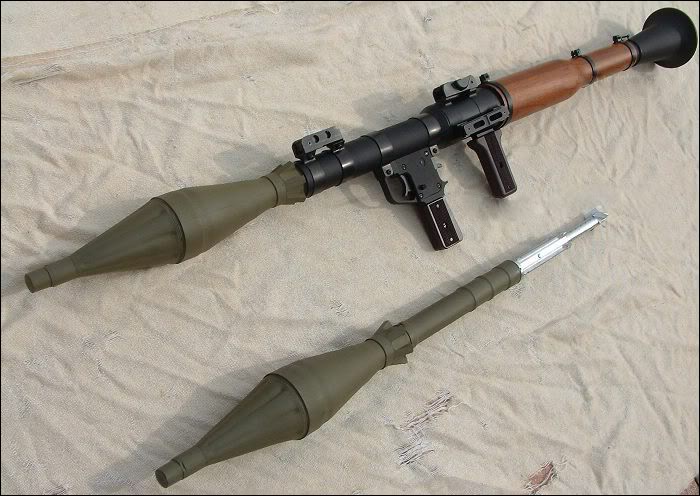Understanding Vietnam 's killing killer
During the war, Vietnam made many enemy troops tremble by the massive army of anti-tank guns B-40, B-41, B-50.
What is Vietnam 's "killer killer" is that makes the enemy worried
B-40 anti-tank gun
RPG-2 is a personal non-shocking anti-tank gun , also known in Vietnam as B40. This gun was widely used in the Vietnam War, then gradually replaced the life after the RPG-7 (or B41 version of Vietnam).
The B40 is just a thin, light, thin tube with an internal diameter of 40 mm. Above the tube there is a viewfinder and the head of the fly folds up, preventing entanglement when transporting, erecting a viewfinder.
The viewfinder only has 3 levels, the farthest is 150 meters, the level of viewfinder is the horizontal bars that are fixed like a ladder. B40 bullets include 2 parts, bullets and launchers. Before inserting a bullet into the gun, the launcher must be loaded into the bullet. The collar part has a nail that is easy to locate, when installing the nail to the mouth of the gun barrel.
The gun shot with a shoulder posture , a hand holding the barrel, a handle. The range ranged 150 meters, many believed that shooting a moving target was only 100 meters, but in fact, the gun fired very accurately, partly because the missiles did not contribute much to the movement of the bullets.
The warhead was detonated by an explosive inertia, the stinger was placed in the neck of the bullet. When the bullets hit the target stopped, the heavy mass of the stinger rushed into the explosive particle.

B-41 weapon and PG-7 warhead
B-41 anti-tank gun
B41 is the Vietnamese name for the RPG-7 anti-tank personal anti-tank grenade launcher . This is an upgraded, modernized variant of the RPG-2 anti-tank grenade launcher. RPG-7 has been greatly improved in terms of launchers, launchers, and armor penetration.
The most important improvement of RPG-7 is the launch mechanism , the projectile is fired by two resources, one from the discharge dose in the discharge tube and from the rocket engine of the warhead. When it comes to RPG-7, it is literally an uncontrolled anti-tank missile. In RPG-2 only part of the missile principle applies.
The rocket engine is activated after the warhead leaves the barrel about 11 meters and is maintained to 500 meters, thanks to the rocket engine, the maximum speed of the warhead reaches 300 meters per second.
In addition, the warhead is much improved in terms of detonators and armor penetration. The RPG-7 uses PG-7V penetrating bullets, the warhead is equipped with an electrically-charged fuse (ie the tip of the warhead is equipped with electrically charged crystals, when it comes to high pressure due to impact, it generates electricity and detonate warheads).
The detonator has a fairly simple structure but requires a very high level of engineering in the fabrication process to ensure accuracy and reliability. Even today, if not transferred to Russia by technology, this detonator is still a big challenge even for industrialized countries.

Vietnamese soldier with B-41
B-50 anti-tank gun
This is essentially a symbol of the anti-tank gun CT-62 designed by the Vietnamese military industry based on the experience of drawing from anti-tank weapons SKZ in the anti-French resistance and learning a part of the technology from RPG. -2 (B-40).
In the early 1960s, the Ministry of Defense assigned the Military Department to chair the research project of manufacturing anti-tank guns CT-62. Z1 factories are responsible for testing guns and processing mechanical parts of the shells, Z2 fabricates explosive tubes, fire particles, stuffing and holding test shots. After nearly 2 years of hard work, the technical staff completed the basic design and put it into the test.
Accordingly, the CT-62 anti-tank gun is manufactured with 35X / CA alloy steel material . In particular, the gun barrel (50mm size) is processed through many stages such as drilling, boring, smoothing and heat to ensure maximum pressure of 700kG / cm2. The length of the barrel is calculated to ensure the initial speed of an average of 82m / s. In order to eliminate the whole recoil, the loudspeaker design is at the tail end.
One of the stages that Vietnamese officials spend a lot of time, high complexity is the manufacture of anti-tank bullets CT-62.
Through the experience of using anti-tank bullets SKZ and B-40 , technicians decided to design 100mm-sized bullets on the principle of having wave breakers like B-40 anti-tank bullets, 60 degrees cone angle (optimal cone angle bullet SKZ). Our staff has made nearly 30 attempts to blast through the steel shaft to determine the optimal distance between the wave break and the top, the thickness of the wave break.
- Crocodiles never intentionally kill people
- He: Called against assassin robots
- Forgotten killer disease: Farmers' bare feet and mud in the field
- The mystery of the class of killer murders killing 12,000 people in London was resolved
- Strangely, killer whales make a living for handicapped children
- Video: Watching the whale 'killer' chasing a strange ship
- Killer whales can die from ... toothache
- Discovered rare white killer whales
- The mystery of the poisonous killing killing more than 600 men, only 4 drops is dead without a trace
- The killer whale finally gave up the corpse after 17 days floating in the ocean
- Mischievous whales use bird trap tips
- The Ministry of Health acknowledges that chemicals killing mosquitoes suspected to cause brain atrophy are imported to Vietnam
 'Fine laughs' - Scary and painful torture in ancient times
'Fine laughs' - Scary and painful torture in ancient times The sequence of numbers 142857 of the Egyptian pyramids is known as the strangest number in the world - Why?
The sequence of numbers 142857 of the Egyptian pyramids is known as the strangest number in the world - Why? History of the iron
History of the iron What is alum?
What is alum?